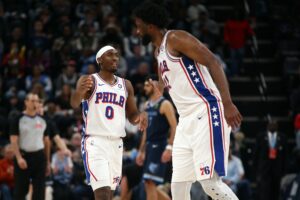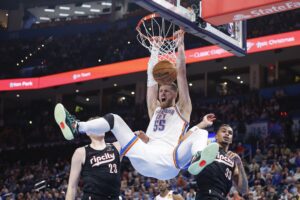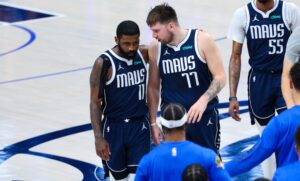The Brooklyn Nets and Portland Trail Blazers have agreed on a trade to send Allen Crabbe to Brooklyn in exchange for Andrew Nicholson.
Adrian Wojnarowski of ESPN first broke the news on Tuesday afternoon:
Portland has traded Allen Crabbe to Brooklyn for Andrew Nicholson, league sources tell ESPN.
— Adrian Wojnarowski (@wojespn) July 25, 2017
Allen Crabbe Trade Analysis
Portland’s Financial Perspective
For the Blazers, it’s all about shedding cap space and their luxury tax bill. Andrew Nicholson is not in their future plans. In fact, he and the $21 million remaining on his contract (over the course of three more years) will be waived as soon as possible.
Last off-season few teams were as aggressive as the Blazers were in taking advantage of the salary cap spike. Like we’ve seen from many other teams, it appears as if Portland regrets dishing out so much money to very mediocre players. GM Neil Olshey committed $202 (!) million last off-season to Allen Crabbe (4 years, $75 million), Evan Turner (4 years, $70 million), Meyers Leonard (4 years, $41 million), and Festus Ezeli (2 years, $16 million). Last summer he also handed C.J. McCollum a four-year extension worth $106 million that kicks in this upcoming season.
After a disappointing 2016-17 season that found the Blazers barely sneaking into the playoffs as the eighth seed, Portland appeared to be a capped-out team with virtually no viable options to improve an underwhelming, overpaid, and mediocre roster for years to come. Frankly, even after shedding Crabbe’s contract off their books and waiving Nicholson, the Blazers still don’t have much financial wiggle room to add new players.
One major benefit of this trade for Portland is the reduction owner Paul Allen will see in his luxury tax bill. According to Bobby Marks of ESPN, this trade – and the subsequent waiving of Nicholson – will save the Blazers nearly $44 million in luxury taxes during just this season alone. Factor in the loss of Crabbe’s salary, and the franchise saves roughly $60 million in taxes and salary for this season. For a small market franchise like Portland, this is quite significant.
Of the four aforementioned free agent signings of last summer, the Blazers definitely regretted signing Crabbe the least, if they even regretted it at all. Turner and Leonard were wildly disappointing, and Ezeli never played a single game due to injury. Crabbe maintained his scoring volume of a little over 10 points per game while improving his efficiency from three-point range from 39% to 44%. The three years and $56 million remaining on his contract is still a bit much for a player of Crabbe’s caliber, but the others were far less tradeable. Not even the Nets, famous for taking on previously deemed untradeable contracts (Joe Johnson circa 2012, Timofey Mozgov circa last month), were willing to trade for Turner or Leonard.
Is a Carmelo Anthony Trade in Portland’s Future?
Damian Lillard and C.J. McCollum have publicly expressed their desire to bring Carmelo Anthony to the Pacific Northwest. One of the largest obstacles, besides getting Anthony to waive his no-trade clause for Portland of course, has been shedding the necessary salary to acquire the future Hall of Famer. Could this trade be the first step for the Blazers to trade for Anthony? At this point it still seems unlikely, but it would be foolish to rule anything out.
One Year Later, Sean Marks Finally Gets His Man
You may recall exactly one year ago when Nets general manager Sean Marks made his first bold move in Brooklyn. He signed then-restricted free agent Allen Crabbe, yes the same Allen Crabbe, to a massive four-year, $75 million contract. This was utterly shocking for so many reasons at the time.
First of all, almost no one knew who Allen Crabbe was. (And quite frankly, most fans only know him now as that player who the Nets gave a ridiculous contract but for some reason Portland matched.)
Secondly, at the time of the signing, the media and fans were still shocked to see lesser players getting such lucrative contracts due to the salary cap spike. It took us a while to become accustomed to teams signing players we haven’t heard of before to contracts worth more than $50 million. One year later and it now sounds somewhat normal when we hear a player who has averaged 9.3 points, 4.4 rebounds, and 1.2 assists in his career (Otto Porter) has been signed to a max contract.
And thirdly, this was the first transaction that suggested what Sean Marks meant when he told Nets fans he had creative strategies up his sleeve to infuse the roster with young talent. Crabbe was the first of three failed attempts (Tyler Johnson and Otto Porter soon followed) by Marks to sign young and talented restricted free agents to lucrative contracts, hoping the offer would be too expensive for the player’s original team to match. Fast forward one year, and Sean Marks finally gets his original target: Allen Crabbe.
What Crabbe Brings to Brooklyn
In 28.5 minutes per game last season, Crabbe averaged 10.7 points, 2.9 rebounds, and 1.2 assists while shooting .468/.444/.847. Despite a very good shooting slash line, Crabbe doesn’t bring much else to the table. However in the modern NBA, a long lanky frame (Crabbe has a 6’11 wingspan) and a knack for shooting the rock may be all it takes to carve out a darn good player in this league.
At just 25 years old, Crabbe can be expected upon to improve. Playing under a coaching staff, led by head coach Kenny Atkinson, that places such a high emphasis on player development should help Crabbe reach his full potential. He should fit in very well with the other young players on Brooklyn’s roster. Expect Crabbe to increase his scoring, especially from beyond the arc, while playing under Kenny Atkinson in Brooklyn.
Financial Impact on Brooklyn
Crabbe and Nicholson both have three years remaining on their contracts. For Crabbe, approximately $56 million remains, and for Nicholson, roughly $21 million remains. For those who watched Brooklyn Nets basketball last season, Nicholson proved to be an unathletic, slow power forward with limited talent. There are questions to whether he belongs in the NBA at all, let alone earning $7 million per year for three more years.
Ignoring sunk costs, this trade can essentially be viewed as paying $12 million more each year than the Nets otherwise would have in order to replace a horrible player – Nicholson – with a sharpshooter who still has room to grow as a player.
After this trade, Brooklyn is just a few million dollars under the salary cap. Before today, the Nets financial flexibility was one of their greatest assets. It’s what allowed them to take on Timofey Mozgov’s contract in order to acquire their new face of the franchise, D’Angelo Russell. It’s also what allowed the Nets to trade for a first and second round pick in next year’s draft by simply taking on DeMarre Carroll‘s salary. The only player or pick moving from Brooklyn to Toronto in that deal was the lowly Justin Hamilton, who will likely never see meaningful minutes in Toronto. Brooklyn was literally given two draft selections as an incentive to take on a bad contract.
There would have been some value in keeping ample cap space to hold leverage over teams in the future. As teams try to rid themselves of their mistakes in the 2016 off-season in anticipation of free agency in 2018, Brooklyn could have gotten some sweet deals by simply taking on unwanted contracts, just like they did this summer. What if, hypothetically of course, a team was so desperate to shed a bad contract, so they could sign one of the premier free agents next summer, that they offered Brooklyn multiple assets? It already happened this year with the Russell and Carroll trades, so one can only imagine the trade market next off-season when more teams are desperate to shed contracts and fewer teams have the cap room to take on the contracts. Brooklyn would have been one of the only teams with the cap space to take on bad contracts, so all of the bargaining power would have been on their side.
Of course, after this trade Brooklyn will no longer be one of those few teams with significant cap room. Marks clearly felt trading for Crabbe was the best use of his cap space. It is very possible that Marks may have been better off being even more patient with his cap space than he has been, which is the only unsettling aspect of this Crabbe trade from the Nets perspective. Only time will tell.
Recapping the Nets’ Off-Season
What an off-season it has been for the Nets. Sean Marks has made a series of shrewd moves that have turned the Nets from a terrible team with few assets and a bleak future into one of the more exciting, young teams in the NBA. After one trade at the deadline and three this summer, the Nets are in an entirely different place right now. Since last trade deadline, Sean Marks has given up the following:
- Bojan Bogdanovic – Two months were left on his contract at the time of the trade; traded for Andrew Nicholson and 2017 first round pick (became Jarrett Allen).
- Brook Lopez – All-time great Net, but only one year is left on his contract.
- Justin Hamilton – Third string center; traded for Carroll & two draft picks from Toronto.
- Chris McCollough – Bounced between D-League and end of NBA bench; included along with Bogdanovic to the Wizards.
- Kyle Kuzma – 27th pick in 2017 NBA Draft; included along with Lopez to the Lakers.
In return, Marks has acquired:
- D’Angelo Russell – 21 years old; 3 years left on rookie deal before he becomes a restricted free agent under Nets’ control
- Allen Crabbe – 25 years old; 3 years, $56 million remaining on contract
- Jarrett Allen – 22nd pick in 2017 NBA Draft
- Timofey Mozgov – 3 years; $48 million remaining on contract
- DeMarre Carroll – 2 years; $30 million remaining on contract
- Toronto 2018 1st and 2nd round picks
Not a bad haul for a general manager who had an uphill battle to climb in order to acquire young assets.
Rondae Hollis-Jefferson is the only player on the roster who was on the team when Marks took over in February of 2016, proving just how much this team has changed in such a short period of time.
Brooklyn’s New Roster
By taking on such large contracts to acquire assets, Brooklyn no longer maintains financial flexibility. However they now have a young core to build around. Add Russell, Crabbe, and Allen to Caris LeVert, Rondae Hollis-Jefferson, Sean Kilpatrick, and Isaiah Whitehead, and all of a sudden there is a nice young core to build around. With the veteran presence of Mozgov, Carroll, Jeremy Lin, and Trevor Booker, the Nets have an excellent blend of veteran leadership and youth.
The most obvious aspect of the Nets roster is their surplus of guards and wings. Mozgov, Allen, and Booker are the only natural power forwards or centers on the roster as of now. Expect this team to chuck up a bunch of threes and play lots of small ball. Crabbe only attempted 3.8 threes per game in Portland last year, yet it wouldn’t be surprising to see him hoist over five per game this season in Brooklyn.
Both Carroll and Hollis-Jefferson figure to get just as much time at the four as they will at the three. Maybe even Crabbe will get some minutes as a four. Kenny Atkinson and Sean Marks are all in on adopting a modern NBA offense.
There is finally a future building in Brooklyn. Marks has magically made something appear out of nothing, and Atkinson is in place to mix and match Mark’s acquisitions together on the court.
Adding Allen Crabbe – one year after they had initially hoped to acquire him – is just one more piece to the puzzle.
Main Photo






